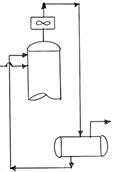Solids Deposition In Refinery Sour Water Systems
 In typical petroleum refinery processing units, such as hydrotreaters, organic S, N and Cl are converted to H2S, NH3 and HCl respectively. In addition CO2 may also be present in the same effluent streams. As a result of downstream cooling and vapor-liquid separation, these inorganic compounds generally wind up concentrated in the aqueous liquid stream(s). These latter streams are then sent to a sour water stripper where these potentially corrosive acid gases can be removed. If process temperatures reach low enough levels, the acid gases can react, and salt or crystal deposition can occur. Crystal formation will produce obvious plugging in the piping. This problem is of particular concern in the overhead condenser tubes of a sour water stripper.
In typical petroleum refinery processing units, such as hydrotreaters, organic S, N and Cl are converted to H2S, NH3 and HCl respectively. In addition CO2 may also be present in the same effluent streams. As a result of downstream cooling and vapor-liquid separation, these inorganic compounds generally wind up concentrated in the aqueous liquid stream(s). These latter streams are then sent to a sour water stripper where these potentially corrosive acid gases can be removed. If process temperatures reach low enough levels, the acid gases can react, and salt or crystal deposition can occur. Crystal formation will produce obvious plugging in the piping. This problem is of particular concern in the overhead condenser tubes of a sour water stripper.
The prime objective of this paper is to provide a methodology to predict the temperature at which crystallization will first occur given the gas phase composition and total system pressure. No attempt is made, however, to predict or estimate the deposition rate or extent of deposition of the crystals.
